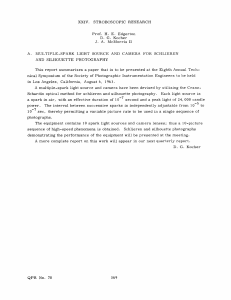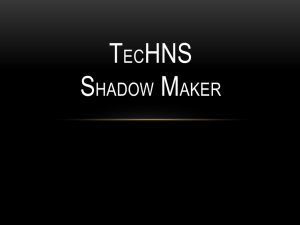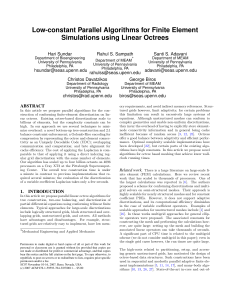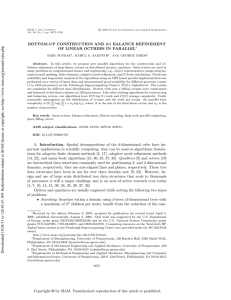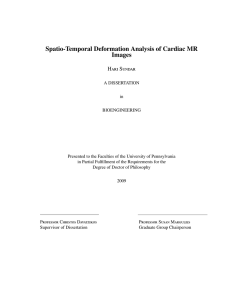Tardi Tjahajdi Image Processing and Expert Systems Laboratory
advertisement
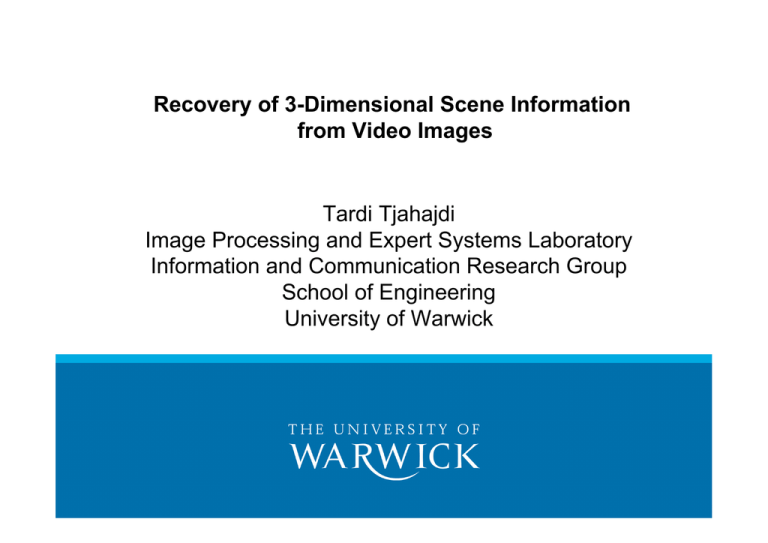
Recovery of 3-Dimensional Scene Information from Video Images Tardi Tjahajdi Image Processing and Expert Systems Laboratory Information and Communication Research Group School of Engineering University of Warwick Contents of the Talk • • • • Brief review of 3D object/scene reconstruction Camera calibration Structure from motion Shape from Silhouette 2 3D Object Reconstruction Methods • Applications: robot navigation, obstacle recognition, digital preservation of works of arts, etc. • Active vision: laser scanning, stereo with structured lighting • Volumetric reconstruction: Space carving (Kutulakos & Seitz, 2000) Voxel colouring (Seitz & Dyer 1999) 3 3D Object Reconstruction Methods (continued) • • Shape from stereo Shape from Silhouette (SfS) • Structure from motion (SfM) SfM (Jebara, Azarbayejani Pentland,1999) SfS (Yemez & Schmitt, 2004) 4 Camera calibration • • • Determines camera parameters • Methods 1 using calibration object • – e.g., Tsai, 1987; Zhang, 2000 – feature detection – camera model Parametric distortions – parametric deviations from pinhole model: methods 1 – parametric models for specific lenses Methods 2 using geometric invariance of image features – e.g., Meng & Hu, 2003 • Precision of calibration depends: • fish-eye transform model, e.g., Basu & Licardie, 1995. • field-of-view model, e.g., Devermay & Faugeras, 2001. Methods 3: self-calibration - e.g., Pollefeys & van Gool, 1999 • Generic (non-parametric) distortions – e.g., Mohr, Boufama & Brand, 1993 5 Multiview camera-calibration framework for nonparametric distortions removal (Vincent & Tjahjadi, IEEE Trans Robotics, 2005) • The mapping between a 3D point P4 = [X,Y ,Z,1]T in an arbitrary world coordinate system and its ideal homogeneous image coordinates p = [x,y,1]T is € € (1) – where R is 3x3 projection matrix, t the translation vector, f x and f y the horizontal & vertical scale factors, α the image skew, and (uo ,vo ) the principal point. • Taking into account of potential deviations, € € € € (2) – where H is 3x3 matrix corresponding to homography • For a multiview calibration framework we need to minimize for all views the differencess between the transformations to obtain a common mapping for all views 6 • Define 2 affine transformations A and A’ for p and P such that (2) becomes (3) – where H = A-1H' A' • For distortion corrections, use a virtual grid defined by P calibration feature points Pi . For each view compute the best homography H j € which minimises the residual error associated with view j (4) € – where • p˜ ij € are the observed sub-pixel coordinates of Pi j For each view, the corrected (undistorted) points p˜ H is given by i (5) € € € 7 • • The estimations are further refined by fusing the corrective distortion maps obtained from different views into a common distortion map, applying this map to correct the distorted pixel coordinates. The corrective distortion vector is (6) k,l k,l – where BH z and BH z are sets of control vectors, N k (u( p˜ ixj )) & M k (u( p˜ iyj )) are B-spline basis function in u & v directions respectively € • The best B-spline surfaces that fit the estimated corrective distortions Hj p˜ i€ − p˜ ij is€given by the residual error € (7) • The distortion vectors are given by the 2 distortion B-spline surfaces. The remaining intrinsic & extrinsic parameters are initialised using Bouguet’s solution on the currently undistorted pixel coordinates. 8 • The parameter vector to optimize is Results Distorted and corrected images. 9 Re-constructing 3D object from an image sequence • Involves correspondence estimation, structure & motion analysis, surface reconstruction • Correspondence estimation (Redert, Hendricks & Biemond, 1999): – characterises the apparent motion of an imaged scene relative to the camera, either by the displacement of a discrete set of features or by the instantaneous velocities of brightness patterns – tracking a set of features: two-frame & long-sequence based • Feature-based structure & motion estimation (Jebara, Azarbayejani & Pentland, 1999): – 2-frame; or iterative and recursive multi-frame – 1st, the rigid motion between the views is recovered; and 2nd, the motion estimate is used to recover the scene structure. • Surface reconstruction: – Define surfaces to pass through recovered 3D feature points 10 3D metric object modelling from uncalibrated image sequences (Cadman & Tjahjadi, IEEE Trans SMC, 2004) System architecture Interactions between system modules 11 General matching procedure • Unguided matching: – when the transformation between the two most recent camera positions (i.e., viewpoints) is unknown – given a feature point in the previous image, a circular area centred at the same location in the current image is searched for the feature's corresponding point • Guided matching: – when the motion of the camera between its two most recent viewpoints has been estimated – uses a dynamic search window Dynamic search window 12 Corner tracking • • • • Initial corner matching: unguided matching to give ≥ 8 matched points Additional corner matching: expected image locations of unmatched feature points are used to guide matching Pseudo corner matching and expiration: to handle disappearance, occlusion & unsuccessful detection of corners Inclusion of new corners: guided matching on original sets of feature points and all expired pseudo corners using more lenient thresholds 13 Structure recovery • To estimate the motion of the camera and structure of a scene from the point correspondences established, as well the camera intrinsic parameters The relationship between a 3D point pi (k −1) that moves to pi (k) due to the rigid motion relative to the camera between two consecutive views is • (8) € € – where i is the feature point index; k is the image frame index; and δR(k) and δt(k) are the interframe rotation and translation respectively. Given N p (k −1) point correspondences ( pi (k −1), pi (l)) , δR(k −1) and δt(k −1) are obtained as a solution to € • € € € € € (9) – the measurement model comprising: camera model, structure model, motion model; 14 – the solution is provided by extended Kalman filter • Camera model (10) • – where yi (k) = (yi,u (k),yi,v (k))T corresponds to the projection of pi (k) = ( pi,x (k), pi,y (k), pi,z (k))T , β is reciprocal of camera focal length Structure model: the 3D location of feature point pi (k) is € (11) € € € • – where αi is depth of feature point Motion model: – the position and orientation of the object-centred €coordinate system is permitted to vary with time, resulting in pseudo object reference frames (PORFs) - Fig. Relationship between 2 PORFs and the current camera reference frame (CRF). Triangle - camera viewing pyramid; square - scene. 15 Surface reconstruction • • A recursive framework which incorporates a recursive score (indicating the likelihood of any 2 feature points begin adjacent to one another on the true surface) is used to estimate the complete topology of the imaged scene. Corner connectivity (12) – where dir(yi (k),yn (k)) is a directness score and λi,n (k) denotes the number of frames in which both features have appeared together – If greater than threshold ⇒ a potential edge • Constrained triangulation € € – Beginning with a convex hull enclosing the object feature points, the triangulated surface mesh is iteratively refined to ultimately yield a constrained triangulation that can produce views consistent with the original images of the scene. – Visibility constraint: none of the surface’s visible facets should obscure or be occluded by a potential edge. 16 Example results • Evolution of the surface overlaying recovered structure of a simulated object • Recovering an object model from a raytraced box sequence 17 Example results • Recovering an object model from the MOVI sequence • Recovering an object model from the hotel sequence 18 Shape from silhouette (SfS) techniques • • • • 3D visual hull: intersection of multiple 3D cones that are created by backprojection of 2D silhouettes of different views of an object onto 3D space. Octree: constructed by projecting an initial bounding cube (which encloses an object in 3D space) onto multiple images of the object taken at different views, and splitting the cube into eight octants if the projection intersects a silhouette Octants: outside, inside or intersection Marching Cube (MC) (Lorensen & Cline, 1987): – estimates surface triangles from intersection octants, and the location of the triangles are determined by the configuration of inside vertices of an intersection octant – MC generated surface may contain unexpected holes or discontinuities due to: connectivity of octants, ambuiguity of MC algorithm, errorneous camera calibration, and imperfect silhouette images. 19 Images Silhouettes Octree 20 8-level octrees and MC surfaces of four test objects: (a)-(d) Images; (e)-(h) Octrees. ; (i)-(l) MC surfaces. (a)-(d) Silhouettes with 10% noise; (e)-(f) MC surfaces from silhouette with 5% noise; (i)-(l)VMC results from silhouette with 10% noise. 21 Surface reconstruction • MC – assumes that intersection octants may include an actual surface which crosses an edge joining two vertices of a surface octant with opposite status, i.e., inside and outside – erroneous decision on an inside vertex supersedes other statuses previously defined in other silhouettes ⇒ lost of surface patches • Voting MC (VMC) (Yemez & Schmitt, 2004) – counts the number of cases classified as outside and identifies an outside vertex if the vote is greater than a threshold Delaunay Triangulation (DT) (Aurenhammer, 1991) – constructs a convex surface by defining tetrahedrons from 3D points. – characterises each tetrahedron by not allowing any point within its circumsphere • 22 Local hull-based surface reconstruction (Shin & Tjahjadi, IEEE Trans IP, 2008) Overview of surface construction process 23 3D objects & volumetric data slicing • 3D object properties – Connectivity: surface of an object should cover the object tightly without any unattached object segments – Continuity: a shape of local convexity is similar to adjacent convexity if they are connected ⇒ object needs to be sliced infinitesimally • • • Uses best VMC vertices Uses octree vertices to define a local convexity Quantized octree slice Siocq – every four points are from the same octant – a binary image plane where a nonzero point represents an octant € – of a non-convex object can have multiple clusters that are linked 8-neighbouring points • Quantized MC slice Simcq : decision on clustering and connecting of clusters is based on a Bayesian rule and a priori information from the quantised octree slice (a) Octree; (b) octree slices 24 € Identifying a local convexity € • A local convexity is identified by: clustering • Using Parzen density € estimator on Simcq and connecting clusters between slices. r Given a cluster conditional pdf p(t | ci ), the problem of clustering is solved r by searching for the maximum probability. ( t -test data, ci -class i) € • nj € (13) - number of data in cluster j Cluster decision function (14) • €Decision function for connecting a cluster (15) • Correlation coefficient between CID and TID’s: (16) (a) 3D pdf cube containing every cluster conditional pdf in a quantised MC slice. (b) Part of a tree table from slice 4 to 7. 25 Local surface construction • • • • A local convexity is defined by two connected clusters in different slices If an object is not convex, a local convexity can have multiple connections Divide multiple connections into n 1:1 connections with an appropriate division so as to minimise possible duplication of surface patches in the common area The division is done along the best representative vector of the multiple clusters (determined using eigen analysis) and according to the normalised data distribution along this vector. € 1:n branching case. To avoid smoothing, the cluster C1 is divided into 3 subregions, R 2 , R 3 and R 4 on the projection of the eigen vector V' and n 1:1 connections are made. € € € 26 Results (a)-(d) test objects: burner, dragon, bust, vase. (e)-(f) the reconstructed surfaces. 27 28 29 Thank you for your attention. Any questions?


